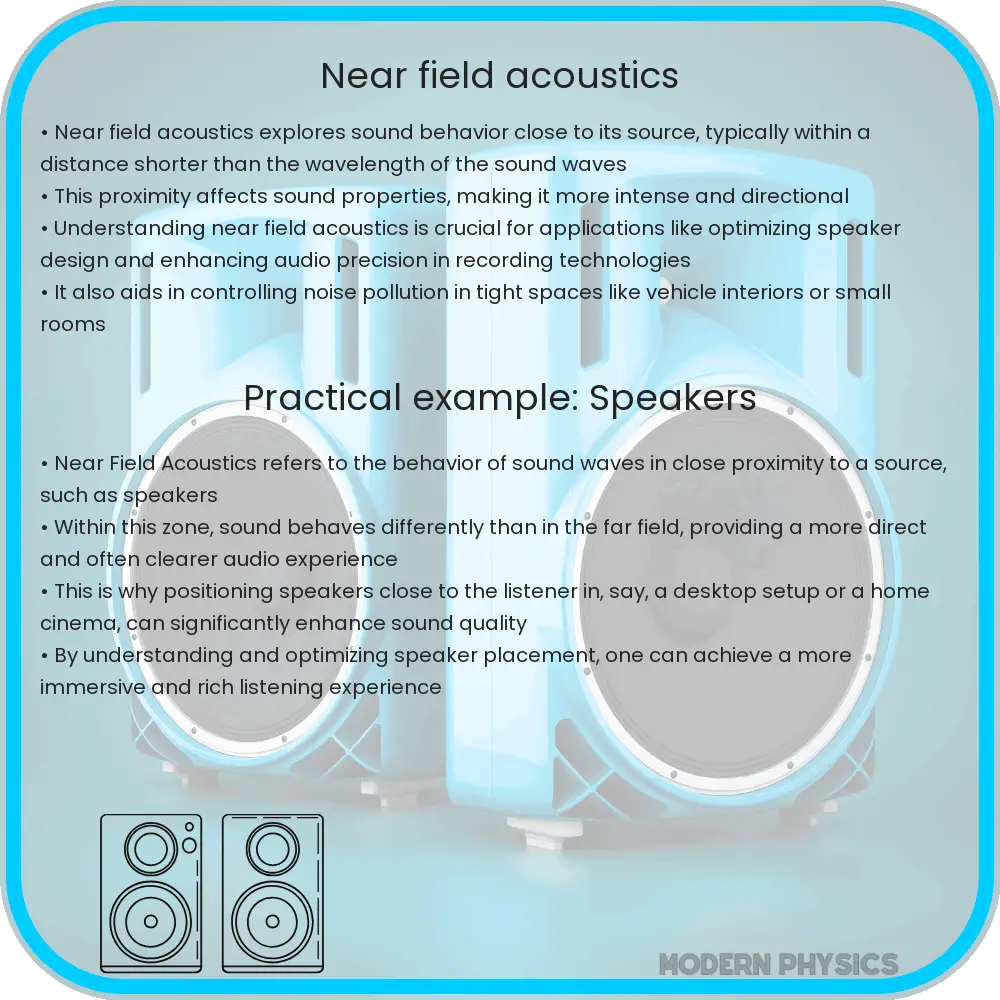Near field acoustics studies sound behavior close to its source, where pressure and phase vary significantly, differing from far-field sound behavior.

Understanding Near Field Acoustics
Near field acoustics refers to the study of sound behavior in the region close to a noise source, where the sound pressure and acoustic phase can vary greatly from point to point. This area is distinctly different from the far-field region, where sound behaves more uniformly and predictably. Near field acoustics is crucial in a variety of applications, from optimizing speaker design to minimizing noise pollution in urban environments.
The Basics of Wave Phenomena
Sound waves are longitudinal waves consisting of compressions and rarefactions of particles in the medium through which they travel. The behavior of these waves can be described by their wavelength, frequency, amplitude, and speed. The intensity of sound is related to its amplitude and diminishes as the distance from the source increases.
In the near field region, which is typically within a few wavelengths from the sound source, the standard wave equations that describe sound propagation in the far-field do not adequately describe the acoustic phenomena. Here, the acoustic variables (pressure and velocity) are strongly dependent on both the distance and the angle relative to the direction of the sound propagation.
Sound Analysis in the Near Field
To analyze sound in the near field, advanced techniques and equipment are used to measure the varying pressure levels and phases. This analysis often involves the use of microphones and sensors that can capture the high spatial variability of sound waves close to their source. Commonly, a probe microphone is moved through the near field region to sample the acoustic field at various points.
The data collected can then be used to visualize the sound field, using methods such as sound intensity mapping or holographic techniques. These visualizations help in understanding how sound energy is distributed very close to the source and how it interacts with nearby objects.
Applications of Near Field Acoustic Measurements
Near field measurements can be incredibly beneficial in several fields. For instance, in audio engineering, understanding the near field behavior of speakers and microphones can help in designing better recording studios and sound systems. In industrial settings, near field acoustics are crucial for noise reduction efforts, helping engineers identify sources of unwanted noise and devising strategies to mitigate them.
Moreover, in urban planning, measuring and analyzing near field noise from vehicles, machinery, and public facilities can assist in creating quieter, more enjoyable urban spaces. The precise nature of near field measurements also enables the diagnosis and troubleshooting of specific components in complex machinery, providing crucial data for maintenance and optimization.
In the following sections, we will dive into some of the specific measurement techniques used in near field acoustics, and discuss challenging scenarios and cutting-edge applications in more detail. Stay tuned to learn how this fascinating area of acoustic research plays a pivotal role in enhancing our everyday experiences and technological advancements.
Advanced Measurement Techniques in Near Field Acoustics
Delving deeper into near field acoustics requires sophisticated measurement techniques that surpass traditional methods. Beamforming and near-field acoustic holography (NAH) are two prominent examples. Beamforming utilizes multiple microphones arranged in an array to pinpoint the exact location of sound sources. This method is highly effective in isolating noise components in complex environments such as factories or busy cityscapes.
Near-field acoustic holography (NAH), on the other hand, constructs a three-dimensional representation of the sound field using data from surface measurements. This technique is particularly useful in automotive and aerospace industries where engineers strive to reduce noise emissions and enhance sound quality within confined spaces such as car cabins or airplane cockpits.
Challenges in Near Field Acoustic Analysis
Despite the advancements in measurement techniques, analyzing sound in the near field presents unique challenges. The proximity of the microphone to the source can introduce errors in data due to reflections or obstructions, occasionally requiring correction or sophisticated calibration techniques. Moreover, the highly variable nature of sound in the near field demands meticulous planning and execution of experiments to ensure the accuracy and relevance of the data collected.
Additionally, the complexity and cost of equipment needed for high-resolution measurements can be a barrier for smaller companies or institutions, potentially limiting access to these advanced acoustic analysis capabilities.
Looking Towards the Future
The field of near field acoustics is continually evolving with technological advancements. Research is being driven by the need for higher precision and more detailed acoustic data to solve increasingly complex noise problems in industrial, urban, and entertainment settings. Innovations in sensor technology, data processing algorithms, and machine learning are expected to further enhance the capabilities and applications of near field acoustic measurements.
As we look to the future, the integration of Internet of Things (IoT) technology could revolutionize how near field acoustic data is collected and analyzed, making it easier to monitor and manage sound environments in real-time. This could lead to smarter urban planning, more efficient industrial operations, and even more immersive audio experiences in virtual reality and gaming.
Conclusion
Understanding and manipulating near field acoustics is crucial for a wide variety of applications, from creating quieter, more pleasant spaces in our cities to designing high-fidelity audio systems. With the help of advanced measurement techniques like beamforming and acoustic holography, coupled with ongoing research and technological innovation, our ability to analyze and control sound in the near field will only continue to improve. This will not only benefit engineers and scientists but also enhance the everyday experiences of the general public, making our world a quieter and more harmonious place to live.
